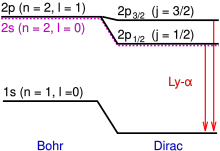|
Lyman-alphaLyman-alpha, typically denoted by Ly-α, is a spectral line of hydrogen (or, more generally, of any one-electron atom) in the Lyman series. It is emitted when the atomic electron transitions from an n = 2 orbital to the ground state (n = 1), where n is the principal quantum number. In hydrogen, its wavelength of 1215.67 angstroms (121.567 nm or 1.21567×10−7 m), corresponding to a frequency of about 2.47×1015 Hz, places Lyman-alpha in the ultraviolet (UV) part of the electromagnetic spectrum. More specifically, Ly-α lies in vacuum UV (VUV), characterized by a strong absorption in the air. Fine structure Because of the spin–orbit interaction, the Lyman-alpha line splits into a fine-structure doublet with the wavelengths of 1215.668 and 1215.674 angstroms.[1] These components are called Ly-α3/2 and Ly-α1/2, respectively. The eigenstates of the perturbed Hamiltonian are labeled by the total angular momentum j of the electron, not just the orbital angular momentum l. In the n = 2, l = 1 orbital, there are two possible states, with j = 1/2 and j = 3/2, resulting in a spectral doublet. The j = 3/2 state has a higher energy and so is energetically farther from the n = 1 state to which it is transitioning. Thus, the j = 3/2 state is associated with the more energetic (having a shorter wavelength) spectral line in the doublet.[2] ObservationSince the hydrogen Lyman-alpha radiation is strongly absorbed by the air, its observation in laboratory requires use of vacuumed spectroscopic systems. For the same reason, Lyman-alpha astronomy is ordinarily carried out by satellite-borne instruments, except for observing extremely distant sources whose redshifts allow the line to penetrate the Earth atmosphere. The line was also observed in antihydrogen.[3] Within the experimental uncertainties, the measured frequency is equal to that of hydrogen, in agreement with predictions of quantum electrodynamics. See alsoReferences
|